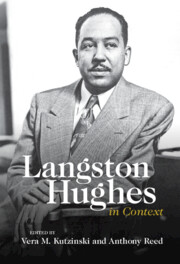Book contents
- Langston Hughes in Context
- Langston Hughes in Context
- Copyright page
- Contents
- Contributors
- Abbreviations
- Introduction
- Part I Singing America
- Part II The Global Langston Hughes
- Part III Afterlives
- Chapter 23 Anthologizing Langston Hughes, 1923–2020
- Chapter 24 Langston Hughes and the Black Arts Movement
- Chapter 25 Langston Hughes’s Jesse B. Simple Story Cycles in German Translation
- Chapter 26 Dreams Deferred in Arabic
- Chapter 27 A Raisin in the (Fallen) Sun
- Chapter 28 Langston Hughes
- Chapter 29 Reading Scottsboro Limited in the Era of Black Lives Matter
- Index
Chapter 26 - Dreams Deferred in Arabic
Translating Langston Hughes from the United States to Egypt
from Part III - Afterlives
Published online by Cambridge University Press: 10 November 2022
- Langston Hughes in Context
- Langston Hughes in Context
- Copyright page
- Contents
- Contributors
- Abbreviations
- Introduction
- Part I Singing America
- Part II The Global Langston Hughes
- Part III Afterlives
- Chapter 23 Anthologizing Langston Hughes, 1923–2020
- Chapter 24 Langston Hughes and the Black Arts Movement
- Chapter 25 Langston Hughes’s Jesse B. Simple Story Cycles in German Translation
- Chapter 26 Dreams Deferred in Arabic
- Chapter 27 A Raisin in the (Fallen) Sun
- Chapter 28 Langston Hughes
- Chapter 29 Reading Scottsboro Limited in the Era of Black Lives Matter
- Index
Summary
The poetry of Langston Hughes has traveled extensively into Arabic through translation, both in formal publications and on the internet. This chapter explores a range of these translations, in Arab American contexts in the United States and within the Arab world, focusing in particular on one poem, “Harlem [2].” It examines the use of Hughes as a symbol of Black America, and representative of Black poetry and arts, as well as some of the intricacies of English-Arabic translation, including a focus on content and meaning over form and stylistics in rendering his work in Arabic.
Keywords
- Type
- Chapter
- Information
- Langston Hughes in Context , pp. 276 - 286Publisher: Cambridge University PressPrint publication year: 2022

